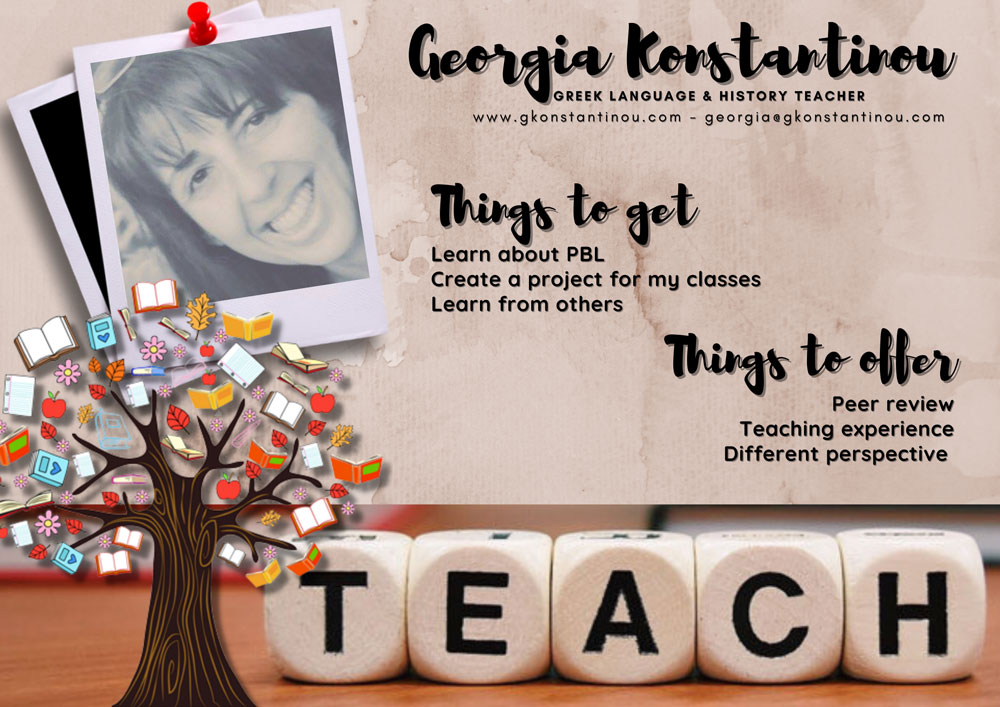Project Based Learning
The first week of this course was very enlightening for me! I learned a little bit about my classmates through an activity that revealed their personality and creativity! We had to create an ad for ourselves. You can see mine below. Through this activity I realized one more time how inventive some people are!!
I also learned a lot about PBL this week. Despite the fact that I have been a teacher for many years and have worked on several projects with my students, I have never worked on one that could potentially have such a significant impact on its community. From all of PBL’s features, I believe this is the one that stands out the most for me. The fact that such projects go beyond the classroom and involve not just the students, but also their small community. I started to consider what type of project I might do with my own students to make such an impact. I believe that projects like this increase students’ engagement and teach them real-world skills, such as teamwork and persistence, essential skills for the workplace of the future. Also they encourage active learning and higher-order thinking skills, since students have to problem-solve and work on their own in order to answer their initial questions or overcome the obstacles that will encounter during the process. I once read an article from Edutopia that had a great impact on me and it was saying that PBL projects help students develop 21st century skills. As 21st century skills the article was listing “personal and social responsibility, planning, critical thinking, reasoning, and creativity strong communication skills, both for interpersonal and presentation needs, cross-cultural understanding, visualizing and decision making, knowing how and when to use technology and choosing the most appropriate tool for the task”. The article made me realize how crucial it is for us, as teachers, to implement PBL projects into our lessons.
Things to remember:
– Project Based Learning is a teaching method in which students gain knowledge and skills by working for an extended period of time to investigate and respond to an authentic, engaging, and complex question, problem, or challenge (PBLworks)
– Seven Essential Project Design Elements
a) A challenging problem or Question
b) Sustained Inquiry
c) Authenticity
d) Student voice & choice
e) Reflection
f) Critique & Revision
g) Public Product
– Seven Project Based Teaching Practices
a) Design & Plan
b) Align to Standards
c) Build the Culture
d) Manage Activities
e) Scaffold Student Learning
f) Assess Student Learning
g) Engage & Coach
– High Quality Framework for QPBL
a) Intellectual challenge and accomplishment: Learn deeply, think critically, and strive for excellence.
b) Authenticity: Work on projects that are meaningful and relevant to their culture, their lives, and their future.
c) Public product: Work is publicly displayed, discussed, and critiqued
d) Collaboration: Collaborate with other students in person or online and/or receive guidance from adult mentors and experts.
e) Project Management: Use a project management process that enables them to proceed effectively from project initiation to completion.
f) Reflection: Reflect on their work and their learning throughout the project.
A couple of resources:
What is PBL & the Gold Standards
High quality PBL framework
Lucas Education Research

The Buck Institute for Education commissioned Common Craft agency to create this short animated video that explains the essential elements of Project Based Learning (PBL).


![10th week’s reflection [8/3 – 8/5]](https://www.gkonstantinou.com/wp-content/uploads/2022/07/pbl-500x383.png)
![9th Week’s Reflection [7/27 – 8/2]](https://www.gkonstantinou.com/wp-content/uploads/2022/07/1_Q9bfz0wD837_Irn20O-ERA-500x383.jpeg)
![8th Week’s Reflection [7/20 – 7/26]](https://www.gkonstantinou.com/wp-content/uploads/2022/07/Role-of-Teachers-in-PBL-500x383.jpg)
![6th & 7th Week’s Reflection [7/6 – 7/19]](https://www.gkonstantinou.com/wp-content/uploads/2022/07/project-500x383.jpg)
![4th-5th Week’s Reflection [6/22 – 7/5]](https://www.gkonstantinou.com/wp-content/uploads/2022/06/bulletin-500x383.jpg)